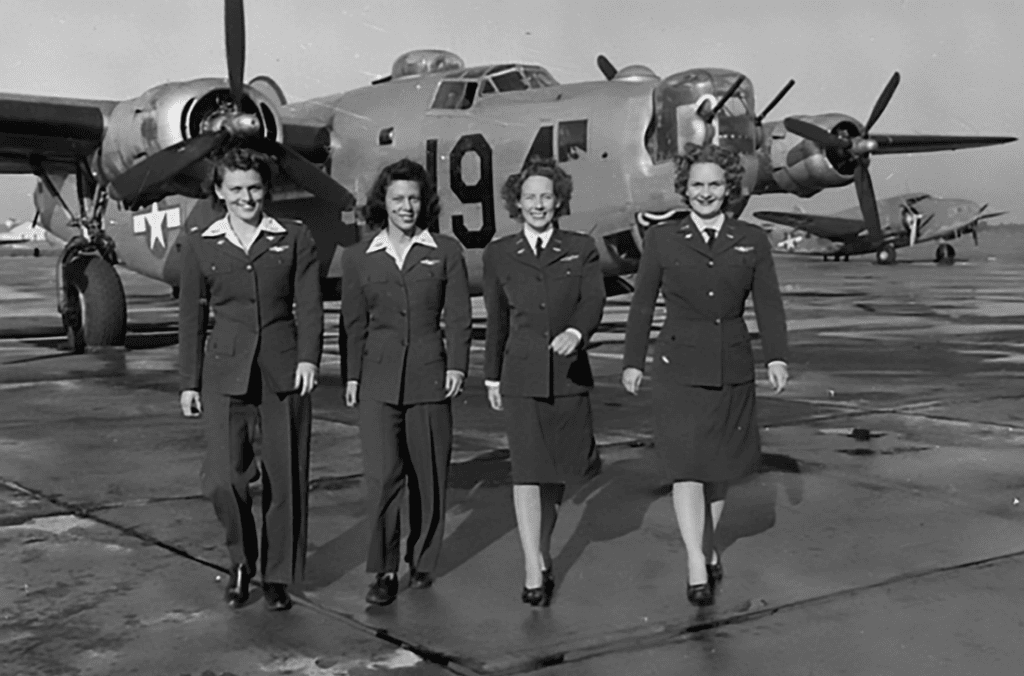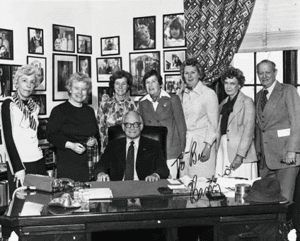
More than thirty years after the WASP were disbanded in December 1944, the women pilots of World War II were shocked by a series of headlines in the paper. The U.S. Air Force announced that women were going to be allowed to serve as military pilots for the first time. WASP from all over the country were incensed that their service to the country had been totally overlooked. “When the Air Force Academy decided they were going to take women, and they made the announcement that for the first time in history women were going to fly military aircraft, it really set a bomb under all of us,” one WASP later recalled. “I thought: ‘Come on, after all we put into that program.”
Much had changed in America since a powerful male pilots lobby shut down the WASP at the end of 1944. In the final months of its existence, the program was under constant attack in the media. “NOT CREATED BY CONGRESS” declared one headline. One writer quoted an unnamed source who predicted the imminent demise of the organization. “We’ll wake up one of these mornings,” the informant allegedly said, “to discover there are no more WASP to sting the taxpayers and keep thoroughly experienced men out of flying jobs.” By contrast, reporters in 1977 were moved and intrigued by the women who had flown military planes during the Second World War.
In the 1940s the media saw no justification in the women’s demands for military benefits. By 1977, reporters felt the lack of benefits was an injustice. One writer explained to readers that when a young female pilot died flying military planes, not only was her funeral not paid for by the U.S. government, her friends on base often had to pass a hat to pay to ship her body home.

Bruce Arnold, General Hap Arnold’s son, and political help from Senator Barry Goldwater-WASP Vet status 1977
In 1976 the WASP found a powerful champion on Capitol Hill in former World War II pilot Senator Barry Goldwater. His first attempt to have the status of the WASP officially
changed to that of World War II veterans came in an amendment to an obscure bill that had already passed the House. The House voted against Goldwater’s amendment. But the Senator from Arizona was not deterred. The following year he presented a WASP bill to the Senate that called for military recognition of the WASPs. In his presentation he threatened to attach a WASP amendment to every piece of legislation that he introduced into the upper chamber if opponents in the Senate continued to block the WASP bill.
The WASP themselves were able to whip up much public and congressional support. Now that several decades had passed since the end of the war, the women were free to discuss publicly what had at the time been classified missions. They talked about their flights and the risks they had taken, and they got members of the public to sign petitions. One WASP discovered an especially good spot for collecting signatures: the lines outside movie theaters for that year’s blockbuster movie, Star Wars.
The WASP did meet powerful opposition from several quarters, including President Jimmy Carter, the American Legion, the Veterans of Foreign Wars and the Veterans Administration. The latter in particular argued that if the WASP were granted veteran benefits, then other civilian organizations that had supported the war effort — the Civil Air Patrol for example — would also begin to lobby for military recognition. In testimony before the Senate Committee on Veterans’ Affairs, the son of World War II General Hap Arnold outlined clearly why the WASP were essentially not a civilian unit. Both Colonel Bruce Arnold and WASP veterans described the military training, the top secret missions, the drills, the uniforms and side arms that made the WASP a military rather than a civilian organization.
The WASP hoped to prove both that the Army had intended to officially militarize them and that in many ways they were a de facto part of the military before the end of the war. In his testimony before a House committee, Colonel Arnold outlined what he called his father’s intentions to militarize the WASP. He concluded his remarks with an impassioned plea: “…Who is more deserving, a young girl, flying on written official military orders who is shot down and killed by our own anti-aircraft artillery while carrying out those orders, or a young finance clerk with an eight to five job in a Denver office?… We hope that this committee will remember that the WASP too have borne the battle, a battle that left 79 of them killed or injured. Not to care for them also makes a mockery of the motto of the Veterans Administration as well as the whole Veterans Administration system in our country.”
A former WASP commanding officer, Byrd Howell Granger, compiled a dossier of more than 100 pages of documents showing that the WASP were subject to military discipline, that they were assigned to top secret missions, and that many of them received service ribbons after their units were disbanded. One document more than any other was especially persuasive. It was an Honorable Discharge certificate granted to WASP Helen Porter by her commanding officer at Strother Field in Kansas. It read: “This is to certify that Helen Porter honorably served in active Federal Service in the Army of the United States.”
In the fall of 1977, both the House and the Senate voted to grant the WASP military status and to make the women pilots eligible for veterans’ benefits. For many of the WASPs, the victory meant more than financial support from the government. It was an acknowledgment of their service and accomplishments during the war. One veteran said, “We were finally recognized for what we had done thirty years before.” Another added that the measure “gave the families of the girls that were killed a feeling that they died for their country.” The victory also meant that a few days after Congress’ decision, Colonel Arnold could triumphantly tell a WASP that she could and should put the Stars and Stripes on the grave of a WASP colleague to commemorate Veterans Day.
Source: PBS.org





